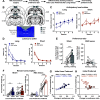Delays to Reward Delivery Enhance the Preference for an Initially Less Desirable Option: Role for the Basolateral Amygdala and Retrosplenial Cortex
- PMID: 34315810
- PMCID: PMC8412996
- DOI: 10.1523/JNEUROSCI.0438-21.2021
Delays to Reward Delivery Enhance the Preference for an Initially Less Desirable Option: Role for the Basolateral Amygdala and Retrosplenial Cortex
Abstract
Temporal costs influence reward-based decisions. This is commonly studied in temporal discounting tasks that involve choosing between cues signaling an imminent reward option or a delayed reward option. However, it is unclear whether the temporal delay before a reward can alter the value of that option. To address this, we identified the relative preference between different flavored rewards during a free-feeding test using male and female rats. Animals underwent training where either the initial preferred or the initial less preferred reward was delivered noncontingently. By manipulating the intertrial interval during training sessions, we could determine whether temporal delays impact reward preference in a subsequent free-feeding test. Rats maintained their initial preference if the same delays were used across all training sessions. When the initial less preferred option was delivered after short delays (high reward rate) and the initial preferred option was delivered after long delays (low reward rate), rats expectedly increased their preference for the initial less desirable option. However, rats also increased their preference for the initial less desirable option under the opposite training contingencies: delivering the initial less preferred reward after long delays and the initial preferred reward after short delays. These data suggest that sunk temporal costs enhance the preference for a less desirable reward option. Pharmacological and lesion experiments were performed to identify the neural systems responsible for this behavioral phenomenon. Our findings demonstrate the basolateral amygdala and retrosplenial cortex are required for temporal delays to enhance the preference for an initially less desirable reward.SIGNIFICANCE STATEMENT The goal of this study was to determine how temporal delays influence reward preference. We demonstrate that delivering an initially less desirable reward after long delays subsequently increases the consumption and preference for that reward. Furthermore, we identified the basolateral amygdala and the retrosplenial cortex as essential nuclei for mediating the change in reward preference elicited by sunk temporal costs.
Keywords: basolateral amygdala; dopamine; orbitofrontal cortex; preference; retrosplenial cortex; reward.
Copyright © 2021 the authors.
Figures







References
-
- Aronson E, Mills J (1959) The effect of severity of initiation on liking for a group. J Abnormal Soc Psychol 59:177–181. 10.1037/h0047195 - DOI
Publication types
MeSH terms
Substances
Grants and funding
LinkOut - more resources
Full Text Sources
